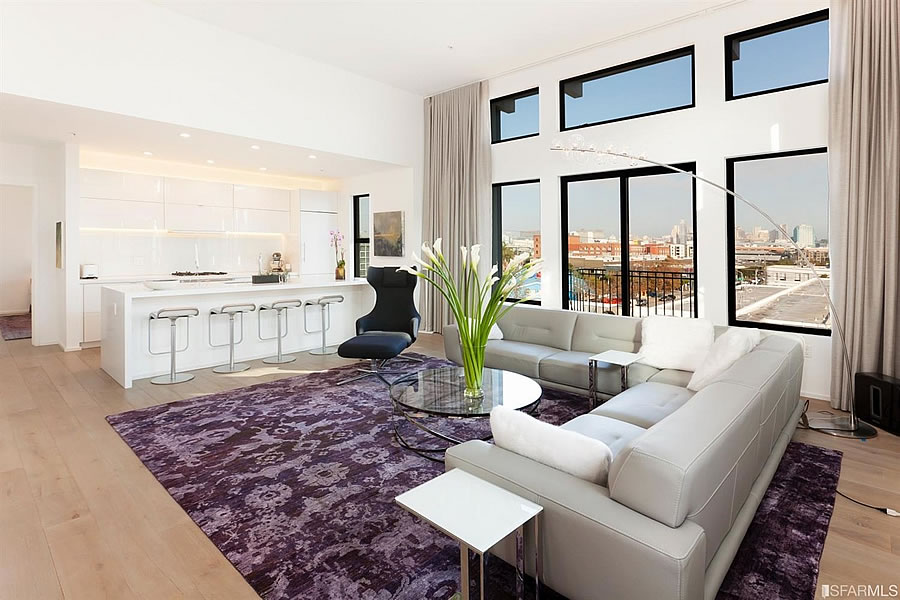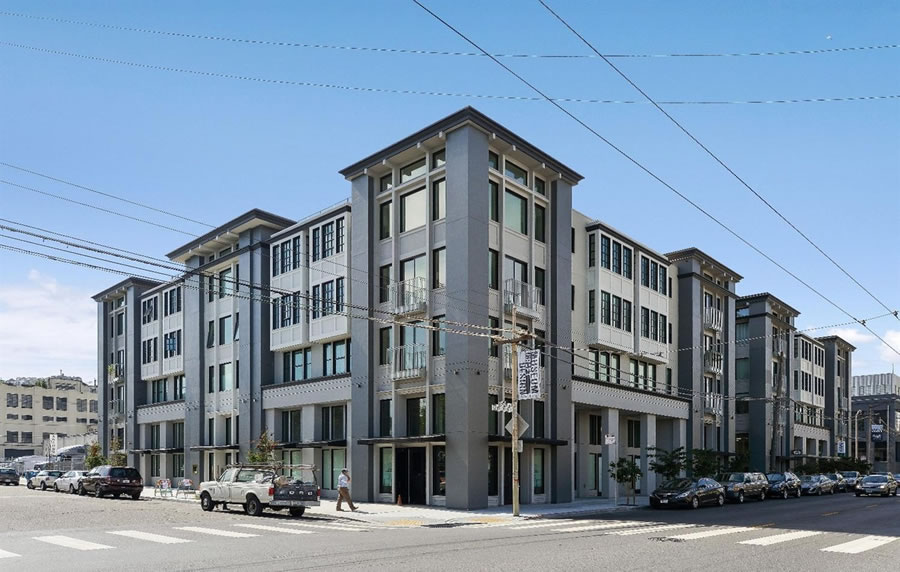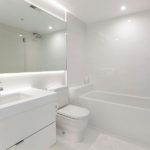Purchased for $1.725 million in May of 2014 and dubbed “the best penthouse in the Onyx,” the two-bedroom unit #407 at 415 De Haro Street, in the flats of Potrero Hill, returned to the market listed for $1.850 million this past November.
The corner unit features an open floor plan with high ceilings, high-end finishes (including a new Sub-Zero wine closet which was installed post-purchase) and the only private roof-deck in the building.
And the sale of the 1,317-square-foot condo has now closed escrow with a $1.8 million contract price or roughly $1,367 per square foot, which represents total appreciation of 4.3 percent since the second quarter of 2014.
Keep in mind that the adjacent penthouse unit fetched its 2014 price early last year, an apples-to-apples outcome which some were quick to dismiss as anomalous.
The current HOA dues for 415 De Haro Street #407, including a $50 per month fee for the deeded parking space, are $553 a month, up from $443 $493 a month in 2014.










The owner clearly lost money, but the bigger issue in my perspective is “Are people really paying this much to live in this neighborhood?” $1300/sq ft with a $533 HOA is insane. That view of downtown is likely to be blocked in the next 5-10 yrs
While the general price of real estate is indeed insane, your “this neighborhood” comment falls flat to me. In many ways this location can’t be beat…incredible access to jobs in Mission Bay, Showplace Square, and also to Caltrain for southbound commuters. A dynamic neighborhood with lots of change and more and more services/amenities, and right down the hill from the established Potrero district. The only downside is you’re limited to muni buses for transit. But biking and walking from this location are great. I, for one, would be very happy to live in that unit.
A “dynamic neighborhood”? hmmm… what do you mean by that. I can agree that this is a reasonably convenient location, but I am not sure what there is in the neighborhood that is particularly exciting or interesting. I would say I am surprised that people are willing to spend quite so much to live here (relative to other parts of the City).
I think it’s the Goldilocks phenomenom. What is “just right”?
For some, a Texas subdivision is too suburban, downtown New York is too metropolitan, and Berkeley with scattered neighborhood hubs is “just right.” For some, skyscrapers of downtown are too high, one- or two-story homes of the surburbia are too low, but the 4-5 story apartment blocks, like in Paris or the Village, are just right.
Heck, suburbia appeals to those who think rural is too spread apart, but cities are too crazy. And Potrero likely appeals to those who want to have some neighborhood amenities, but not so many that it’s too loud at night. There’s a family-friendly, quiet, small-town vibe to it, while still being a little urban edgy and central.
“This neighborhood” has a higher median rent than Nob Hill.
exactly. that’s the point. it has gotten ahead of itself.
No, that’s not exactly the point. You asked if people are really paying this much to live in this neighborhood, and obviously the answer is yes. If your point is that you wouldn’t pay that much, then you should have formulated it differently.
Definitely under-performed. Some individual deals will do better than the broader measures; some will do worse.
Another recent sale in this price range: 2130 Hayes, sold for $1,950,000 in Sept. 2015, just resold on Friday at $2,125,000, up 9% in about 2 years, right in-line with the Case Shiller condo index.
Of course, while the unit your picked on Hayes was purchased as a TIC in 2015, it is slated to be condo converted this year.
Care to guess what happens to the value of a TIC as it approaches condo conversion and added liquidity? Regardless, the unit still under performed the Case-Shiller index for Bay Area condos.
So it was sold as a TIC in 2015 and sold as a TIC again a couple days ago. You’re reaching there. Toh-may-toe, Toh-mah-toe.
Despite protestations to the contrary, you really don’t understand how, or when, the conversion process adds value at each step of way, especially in the current environment with a 3-unit building.
I understand it as well as anyone, having gone through a condo conversion about 15 years ago.
This place has not yet converted! In 2015, the buyer had to arrange for a TIC loan (or pay cash). In 2018, the buyer also had to arrange for a TIC loan (or pay cash). The unit was under rent control for the 2015 buyer. Same with the 2018 buyer. There really wasn’t a material difference between the 2015 and 2018 purchases — except the market is about 9% higher now, as confirmed by the broader indexes.
You’re just grasping at straws to try to mask the fact that you cherry pick examples that give a misleading market picture. Your right to do that. But that doesn’t change the fact that you’re doing it. That someone paid $2,125,000 for a NOPA TIC pretty much sums up the state of the SF housing market.
As we said and right on cue, despite protestations to the contrary (“having gone through a condo conversion about 15 years ago”), you really don’t understand how, or when, the conversion process adds value at each step of way, especially in the current environment with a 3-unit building (hint: time and certainty matter).
Now back to the second of two apples-to-apples sales in the same building, both of which were “picked” prior to our having any knowledge of where the apples would land…
Well, if we accept your argument, then this place is REALLY going to be worth a lot after it actually condo converts, which is a real, tangible milestone. What do you think, this NOPA soon-to-be-condo in a 3-flat will be worth, what, $2.5 million? $2.7 million? And this indicates market weakness?
@anon: Give me a break; the fact that it is approaching condo conversion obviously adds value. Your attempt to deny that makes you look silly. Don’t accuse others of “grasping at straws” when [in] your initial post you were definitely hiding the ball.
In July 2015, it was a TIC with “Condo conversion slated for 2018.”
In Dec. 2017, when next listed, it was a TIC with “Condo conversion slated for 2018.”
Still needed a TIC loan. Still under rent control. No material difference. I agree that a unit can take a leap in value at the time it is approved for a condo conversion, and after it completes the condo conversion. Neither status changed at all between the 2015 and 2018 sales. If you’re trying to argue that a unit slated for a condo conversion magically appreciates each day as the conversion date approaches, that is just silly. And again, if we accept your logic, this unit in a 3-flat will be worth $2.5 million or more after the conversion (a real event) – which just proves the market is crazy strong right now.
This unit appreciated 9% in two years, apples-to-apples. Sorry that doesn’t fit the wishful mentality of many; but it does fit the reality of the SF market over the past couple of years.
So if you were holding two identical units, one of which was slated to condo convert in three years times and the other which is slated to convert this year (with two fewer years of uncertainty, two years of lower mortgage costs, and added liquidity two years before the other), your professional opinion is that the value of the two units would be the same?
I’ve been in that very market – not a huge difference. Maybe a couple %, at most.
Material jump after approval to condo convert — but that was baked in at the time of the 2015 sale and unchanged at the recent sale.
Look, by the same token, one could point out that this Potrero Hill unit you’ve featured was brand new in 2014 — brand new appliances, flooring, HOA fees were lower. Now you’re getting a place with 4 years of wear and higher HOA fees. Not an apple to apple sale and yet it still sold for 4.3% more! One can nitpick anything. Cherry-picking and nit-picking are weak methods to try to make a point.
Perhaps it has something to do with the fact that you were “in that very market” 15 years ago, but you really don’t seem to have a solid grasp on the value of time when it comes to a condo conversion in today’s market or how to value/discount an additional two years as a TIC.
But you’re right, the Potrero Hill sale wasn’t exactly apples-to-apples as a new Sub-Zero wine closet was installed between the two sales (as noted and pictured in the gallery above).
Seller here. 🙂
I jumped on an opportunity to upgrade to a SFH up the hill earlier in the fall, knowing full well I’d have to take a small loss on my condo after such a short ownership time plus some upgrades, and knowing I overpaid a bit originally due to competition and market forces of 2014. Not only that, but the timing dictated being ready to come on the market during a slow period of the year.
Without staging or any prep work and off-market during the new year I got a decent offer that exceeded what I paid and minimized the loss from the move. Strong buyer, very good timing, and some off-contract details made it a pretty simple decision. I believe it is still a price per square condo record for Potrero but I may be mistaken.
Every buyer and seller’s situations are unique. The building is lovely. But for the opportunity to upgrade to a rare Potrero Hill SFH that perfectly fills my needs long term, I’d have been happy there for a long time, well long enough to make it a better investment.
congrats!
Thank you!
@MSMLT: when the HOA went up from $443 to $553 was there a vote on it? just curious how it works, like is it put up for a vote by the unit owners, or is it simply decided by either the HOA board, or decided by the hired external HOA management.
So the reported HOA fee change above is misleading, and should probably be corrected by the editor as it isn’t apples to apples. When the building first hit the market, parking was optional, and it adds another $50 monthly fee. A space was purchased and deeded with the unit at that time, so the fees were in practice $493 on day 1, and the $553 includes that $50. Fees have increased a bit over 10% by the fourth yearly budget which is not extraordinary. New buildings can take a few years to settle on vendors and be able to anticipate costs enough to budget reliably. And vendor costs rise over time naturally.
Generally speaking CC&R documents will determine how fees charged be increased. Often it is the board, with notice given to owners. But I imagine this can and does vary HOA by HOA.
[Editor’s Note: Since updated above.]
thanks for the insight and answering that!